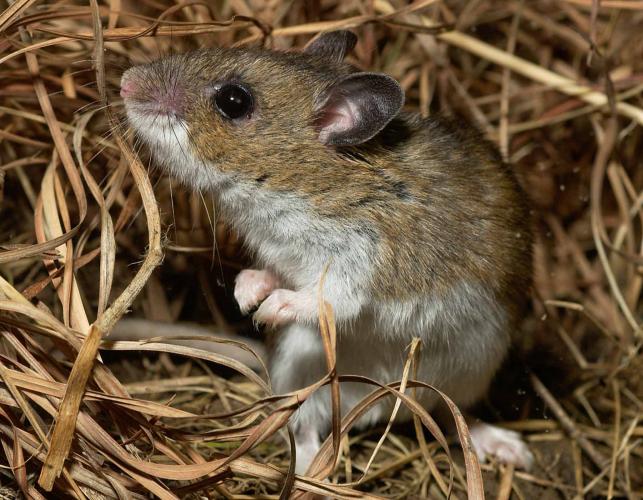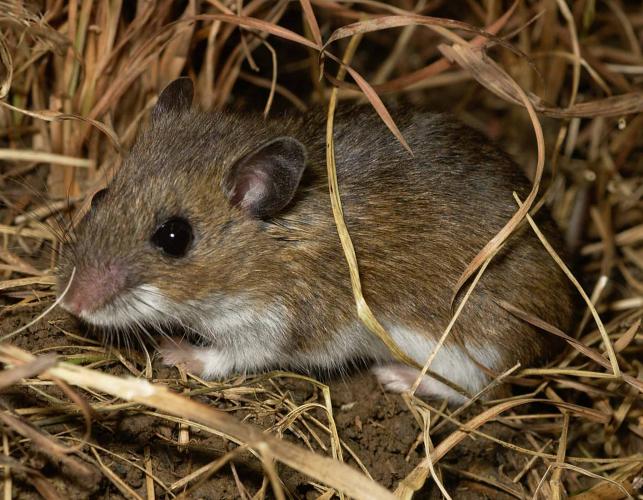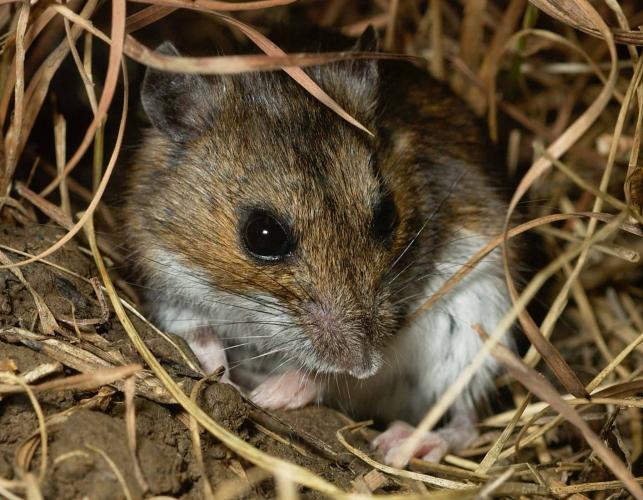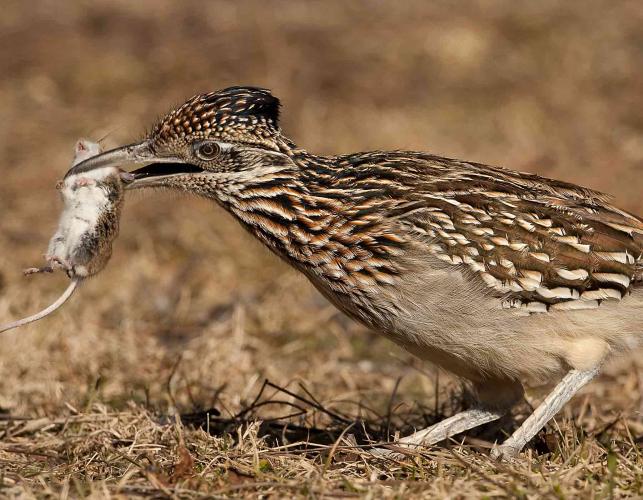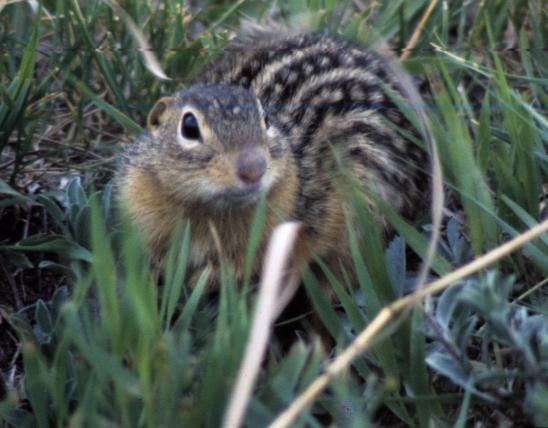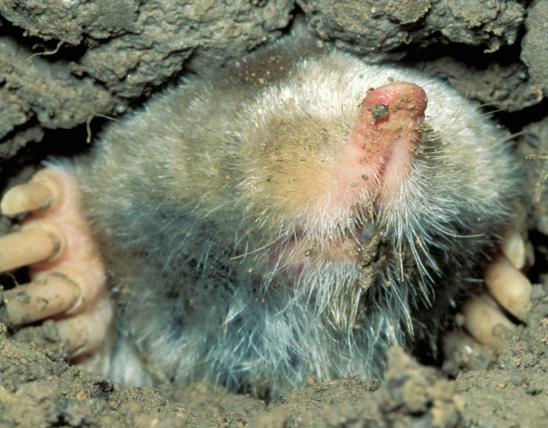
The deer mouse, also called the North American deermouse, is a small rodent with large, protruding, black eyes; large, scantily furred ears; long, coarse whiskers; and a moderately to well-furred tail from one-third to less than one-half of the animal’s total length with a slight tuft at the tip. There are 4 clawed toes and an inconspicuous nailed thumb on each front foot, and 5 clawed toes on each hind foot. The soles of the hind feet are thinly furred from the heel to the 6 pads, or tubercles. Small internal cheek pouches are present. The body fur is long and soft.
There is considerable color variation in individuals in this species, but in general the back and sides of the adults vary from grayish to reddish brown with or without a darker area in the middle of the back. This color is sharply marked off from the lower face and underparts, which are white or sometimes grayish. The base of the hairs on both back and belly is dark gray. The feet are white. The tail is dark like the back above and sharply contrasted to light like the belly below. The ears are dark brown for approximately the outer half with a very slight grayish to whitish margin but are whitish to pinkish for the inner half.
Key Identifiers, Adults:
- Color of upperparts is sharply marked off from underparts.
- Total length less than 9 inches.
- Upper incisors not grooved.
- Tail considerably more than twice the length of hind foot; ears projecting beyond fur.
- Tail not bushy.
This mouse species is widely distributed in North America and exhibits great variation in form, behavior, and habitat preferences. The subspecies that occurs in Missouri is Peromyscus maniculatus bairdii.
Similar species: Missouri's four species of Peromyscus mice are similar in appearance and habits. The best way to distinguish between them is by differences in size and characters of the tail. Our other Peromyscus species are
- the white-footed mouse (or white-footed deermouse, P. leucopus), which usually is larger and usually has a slightly longer tail that lacks the sharp color contrast between upper and lower surfaces; it lives mostly in wooded areas.
- the cotton mouse (or cotton deermouse, P. gossypinus), which is similar to but slightly larger than the white-footed mouse; it lives in moist, timbered areas, and in Missouri it is restricted to the Mississippi lowlands of the Bootheel.
- the Texas mouse (or Texas deermouse, P. attwateri), which closely resembles the deer mouse but is slightly larger with a longer, strongly two-colored tail that has a fur tuft at the tip; the flanks are paler than those of the deer mouse. In Missouri, it occurs in the southwestern part of the Ozark Highlands, where it is confined to particular habitats in the White and Elk River drainages.
In areas where these species occur together, their sizes can be intermediate, so they can be very difficult to identify to species. For accurate species identification, specimens should be examined by a person familiar with these species.
Also, keep in mind that Missouri has — in addition to members of the genus Peromyscus — about 20 other species of small mice, rats, and voles. Missouri mice that look most similar to the deer mouse are the golden mouse, two species of harvest mice, the house mouse, the meadow jumping mouse, and the plains pocket mouse.
Total length: 4 3/8–8 inches (usually 6 inches or less); tail length: 1 5/8–3 7/8 inches (usually 2 1/2 inches or less); weight: 1/3–1 ounce.
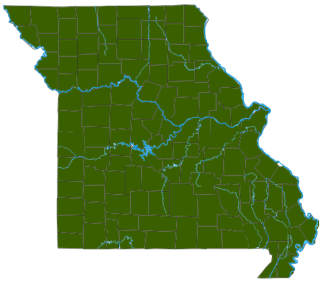
The deer mouse lives throughout Missouri and is one of the most abundant mammals on open lands. The species is widespread across North America, ranging throughout central and southern Canada, the United States, and into southern Mexico.
Habitat and Conservation
In Missouri, the deer mouse is usually found in open habitats such as pastures, meadows, prairie, cultivated fields, and along field borders and fencerows. It may also live in and around human habitations, but it generally does not occur in heavy brush or wooded places.
A deer mouse's several nests are generally located underground in cavities among the roots of trees or shrubs, beneath a log or board, or in a tunnel built either by another animal, but no longer used by it, or by the mouse itself. Less often, the nests may be aboveground in a hollow fence post, stump, log, or an old bird’s or squirrel’s nest.
In Missouri, this species seldom occupies the same range as its close relative, the forest-dwelling white-footed mouse.
In Missouri, the highest populations of deer mice occur from March through June. Local populations fluctuate greatly from year to year, with peaks occurring about every 3–5 years.
Food
The important foods of deer mice are insects (beetles and larvae of butterflies and moths), nuts, wild seeds, domestic grain (corn and soybeans), fruits and fruit pits, and some leafy vegetation. Occasionally they eat fungi, snails, slugs, worms, spiders, centipedes, millipedes, eggs and young of birds, and dead mice. In the fall, seeds and nuts are stored in holes in the ground, in old bird nests, or in trees. These caches may contain as much as 1 pint of food. Deer mice do much of their feeding at these storehouses. The food is carried in the small cheek pouches, which together hold about 1 teaspoon of seeds. Although deer mice are active outside their nests mostly at night, they shun the hours of brightest moonlight. The customary feeding periods are during early evening and just before dawn.
Life Cycle
The principal mating periods are in spring and fall, but limited breeding takes place in summer and, if there are remarkably mild temperatures and abundant food, even in winter. The gestation period is generally from 21 to 23 days but may be extended up to 37 days in nursing females. From 1 to 9 young are born per litter with 3 and 4 the most common. Mated mice usually stay together during the breeding season, if both survive; otherwise, new mates are acquired. In the wild, deermice may live as long as 1½ or 2 years. However, fewer than one-fifth of those born usually reach sexual maturity. The record of longevity in captivity is 8 years.
Human Connections
Deer mice and other mice damage some crops and stores of grain. In western states, they dig up seeds planted for reforestation. In the fall, they commonly enter buildings, where they leave their droppings and become a nuisance.
Although not yet identified in Missouri, hantaviruses that cause hemorrhagic fever with renal syndrome and hantavirus pulmonary syndrome have been identified in the deer mouse, white-footed mouse, hispid cotton rat, and marsh rice rat within the United States. As of 2018, nearly every state surrounding Missouri has reported at least one case of hantavirus. Because this disease is fatal in about 36 percent of the cases, people should be careful about handling rodents, their urine, droppings, and nesting materials. Since it is hard to tell if a mouse or a rat carries hantavirus, it is best to avoid all wild mice and rats and to safely clean up any rodent urine, droppings, or nesting materials with a disinfectant or a mixture of bleach and water. The deer mouse and other mammals have also been associated with the spread of plague and Lyme disease.
If you are experiencing problems with larger numbers of mice, contact a wildlife professional for advice, assistance, regulations, or special conditions for handling these animals. This is especially important in areas with large amounts of mouse droppings, where protective clothing and equipment are recommended.
Ecosystem Connections
Deer mice are very important as a prey species for carnivorous animals. In fact, when they are abundant and form a ready supply of food, their predators likewise become abundant.
These mice consume large quantities of weed seeds and insects.
Their waste products return nutrients to the soil. In the case of such a common animal, the value of this fertilization is considerable.
The high reproductive capacity of deer mice and most other small rodents is balanced by a host of adverse factors. They are preyed upon by opossums, short-tailed shrews, foxes, coyotes, weasels, skunks, minks, badgers, bobcats, domestic cats, hawks, owls, and snakes.
Also, mites, ticks, lice, fleas, botfly larvae, roundworms, and tapeworms take a toll as well.
A large number of mice die because of cold weather and associated food shortages, and their bodies feed animals that scavenge.
